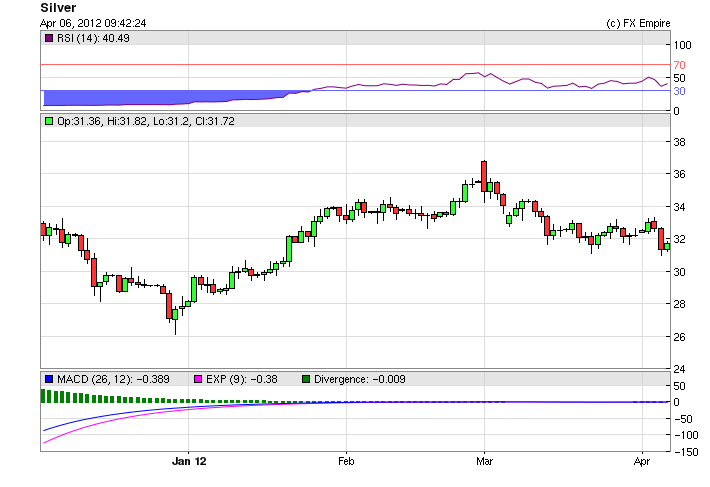By FXEmpire.com

Silver Monthly Fundamental Forecast April 2012
Outlook and Recommendation
Silver at this writing is trading at 31.72
For the month of March silver traded in the range shown below:
Silver’s wild days may be behind it.
The so-called devil’s shine ran up 33% in the first two months of 2012, before giving up almost half of the gains. But for silver, this is relatively smooth sailing. Last year, it chalked up a 57% rally between January and April, before finishing 2011 down 9.8%.
Silver tracked gold higher after ending at lowest level since January Gold and silver futures rebounded modestly as the dollar eases a little and as investors buy into the metals, beaten down of late on dashed expectations for further U.S. monetary stimulus
High collateral requirements are helping keep price volatility at bay. Initial margin paid on benchmark Comex 5,000-ounce silver futures is $21,600, which equates to about 13% of the notional value of a contract. The equivalent figures for gold and crude oil are $10,125, or 6%, and $6,885, or 6.6%, respectively.
Higher margins deter speculators: The number of open futures contracts is hovering just above 100,000, well below last year’s peak of 150,000. And while demand for physical silver as an investment climbed last year, it still accounted for only 14.2% of demand overall, according to metals consultancy CPM Group.
Silver’s fortunes are more exposed to the global economy. Industrial applications, photography, electronics and jewelry accounted for about 86% of total demand in 2011, according to CPM. Being bullish on more industrial demand for silver is difficult with Europe’s economy in the mire, slower growth seen in China and a fragile recovery in the U.S. Hence, silver futures are down 10.5% from their February peak of $37.14 a troy ounce.
FED INTEREST RATE DECISION
Cons.: Previous: 0.25%
The Board of Governors of the Federal Reserve announces an interest rate. This interest rate affects the whole range of interest rates set by commercial banks, building societies and other institutions for their own savers and borrowers. It also tends to affect the exchange rate. Generally speaking, if the Fed is hawkish about the inflationary outlook of the economy and rises the interest rates it is positive, or bullish, for the USD.

Originally posted here



